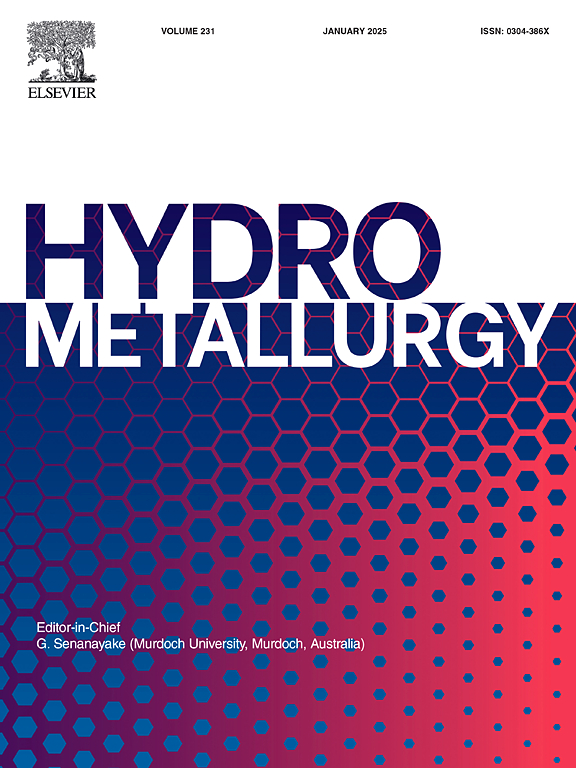Improving acid-free and selective leaching of lithium from end-of-life LiFePO4 batteries using sodium persulfate: Impact of removing organic matter by thermal treatment in an inert atmosphere
IF 4.8
2区 材料科学
Q1 METALLURGY & METALLURGICAL ENGINEERING
引用次数: 0
Abstract
This study reports an acid-free, efficient, and selective method for Li leaching at room temperature from end-of-life (EoL) LiFePO₄ (LFP) batteries using sodium persulfate (Na₂S₂O₈) as a promising lixiviant. The objective of this study is to leach target metal, i.e., Li, as efficiently as possible while minimizing chemical consumption. First, valuable metal-containing materials called black powders (BPs) were recovered from actual EoL LFP batteries. Then, thermal treatment at 500 °C in a non-active, i.e., inert, atmosphere was employed to remove organic matter derived from the binder and electrolyte in the BPs, significantly enhancing leaching efficiency (LE). Under optimal conditions (0.4 M Na2S2O8, 100 g/L pulp density, room temperature, and 30 min), Li was leached with an efficiency of 99.9% and a selectivity of more than 99.5% over Fe and P. This study highlights the importance of organic matter removal for achieving high Li leaching efficiency with minimal Na2S2O8 consumption and suggests the potential of Na2S2O8 for sustainable Li recovery in LFP hydrometallurgical processes.

使用过硫酸钠改善报废LiFePO4电池中锂的无酸选择性浸出:惰性气氛中热处理去除有机物的影响
本研究报告了一种在室温下从报废(EoL) LiFePO₄(LFP)电池中提取锂的无酸、高效、选择性方法,该方法使用过硫酸钠(Na₂S₂O₈)作为有前途的浸出剂。本研究的目的是在尽可能减少化学消耗的同时,尽可能有效地浸出目标金属,即Li。首先,从实际的EoL LFP电池中回收了一种名为黑粉末(bp)的有价值的含金属材料。然后,在500°C的非活性(即惰性)气氛中进行热处理,以去除bp中粘合剂和电解质中产生的有机物,显著提高浸出效率(LE)。在最佳条件下(0.4 M Na2S2O8, 100 g/L矿浆密度,室温,30 min), Li的浸出效率为99.9%,对Fe和p的选择性超过99.5%。该研究强调了有机物去除对以最小Na2S2O8消耗实现高Li浸出效率的重要性,并表明Na2S2O8在LFP湿法冶金过程中可持续回收Li的潜力。
本文章由计算机程序翻译,如有差异,请以英文原文为准。
求助全文
约1分钟内获得全文
求助全文
来源期刊

Hydrometallurgy
工程技术-冶金工程
CiteScore
9.50
自引率
6.40%
发文量
144
审稿时长
3.4 months
期刊介绍:
Hydrometallurgy aims to compile studies on novel processes, process design, chemistry, modelling, control, economics and interfaces between unit operations, and to provide a forum for discussions on case histories and operational difficulties.
Topics covered include: leaching of metal values by chemical reagents or bacterial action at ambient or elevated pressures and temperatures; separation of solids from leach liquors; removal of impurities and recovery of metal values by precipitation, ion exchange, solvent extraction, gaseous reduction, cementation, electro-winning and electro-refining; pre-treatment of ores by roasting or chemical treatments such as halogenation or reduction; recycling of reagents and treatment of effluents.
 求助内容:
求助内容: 应助结果提醒方式:
应助结果提醒方式:


